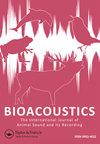希望之声:利用声学模板匹配寻找极度濒危物种
IF 2.1
4区 生物学
Q2 ZOOLOGY
Bioacoustics-The International Journal of Animal Sound and Its Recording
Pub Date : 2023-10-23
DOI:10.1080/09524622.2023.2268579
引用次数: 0
摘要
摘要被动声监测(PAM)在生物多样性监测中越来越受欢迎。它产生了大量的数据,可以为了解环境退化的长期后果提供基础。然而,从如此广泛的数据集中提取生物信息可能具有挑战性,并且需要先进的计算技能。本文介绍了一种简化的工作流程,用于检测三种极度濒危鸟类:樱桃喉塔纳ager (Nemosia rourei), Alagoas Antwren (Myrmotherula snowi)和蓝眼斑鸠(Columbina cyanopis)的声音信号。由于这些物种是世界上最濒危的鸟类之一,寻找新的种群是当务之急。我们根据声乐曲目的声学参数选择潜在模板,并使用已知成分的音景(金标准数据)评估它们的表现。为了评估模板的效率,我们使用了精确率和召回率指标,并发现实现高精确率是以召回率为代价的。尽管我们使用了金标准数据来校准我们的算法,但大规模验证已经揭示了一些模板的局限性,因为一些模板显示出明显较低的精度值。使用二项式模型帮助将精度值重置为90%。我们的工作流程可以有效地处理大量数据,帮助监测这些极度濒危物种的种群,定位新的种群并评估种群动态。关键词:pambioacoustic conservationnemosia rouroureimymmotherula snowolbibiina cyanopis致谢我们要感谢所有辛勤工作的现场工作人员。CONICET为CBdA提供博士后奖学金。披露声明作者未报告潜在的利益冲突。补充资料经费这项工作得到了全国调查委员会Científicas的支助。本文章由计算机程序翻译,如有差异,请以英文原文为准。
The sound of hope: searching for critically endangered species using acoustic template matching
ABSTRACTPassive acoustic monitoring (PAM) has become increasingly popular in monitoring biodiversity. It produces large amounts of data and can provide a foundation for understanding the long-term consequences of environmental degradation. However, extracting biological information from such extensive datasets can be challenging and requires advanced computational skills. Herein, we introduce a streamlined workflow for detecting acoustic signals of three critically endangered birds: Cherry-throated Tanager (Nemosia rourei), Alagoas Antwren (Myrmotherula snowi), and Blue-eyed Ground-dove (Columbina cyanopis). As these species are among the world’s most endangered birds, locating new populations is a top priority. We chose potential templates based on the acoustic parameters of the vocal repertoire and evaluated their performance using soundscapes with known composition (gold standard data). To evaluate the efficiency of the templates, we used precision and recall metrics and found that achieving high precision rates comes at the cost of recall rates. Although we used gold standard data to calibrate our algorithm, large-scale validations have revealed the limitations as some templates have exhibited significantly lower precision values. The use of binomial models helped reset precision values to 90%. Our workflow can process large amounts of data efficiently, helping to monitor populations of these critically endangered species, locate new populations and evaluate population dynamics.KEYWORDS: PAMbioacousticsconservationNemosia roureiMyrmotherula snowiColumbina cyanopis AcknowledgementsWe wish to thank all field personnel that work hard to keep the lights on. CONICET provided a post-doc fellowship to CBdA.Disclosure statementNo potential conflict of interest was reported by the author(s).Additional informationFundingThe work was supported by the Consejo Nacional de Investigaciones Científicas y Técnicas.
求助全文
通过发布文献求助,成功后即可免费获取论文全文。
去求助
来源期刊
CiteScore
4.50
自引率
0.00%
发文量
25
审稿时长
>12 weeks
期刊介绍:
Bioacoustics primarily publishes high-quality original research papers and reviews on sound communication in birds, mammals, amphibians, reptiles, fish, insects and other invertebrates, including the following topics :
-Communication and related behaviour-
Sound production-
Hearing-
Ontogeny and learning-
Bioacoustics in taxonomy and systematics-
Impacts of noise-
Bioacoustics in environmental monitoring-
Identification techniques and applications-
Recording and analysis-
Equipment and techniques-
Ultrasound and infrasound-
Underwater sound-
Bioacoustical sound structures, patterns, variation and repertoires

 求助内容:
求助内容: 应助结果提醒方式:
应助结果提醒方式:


